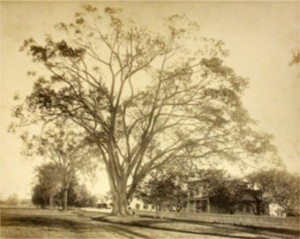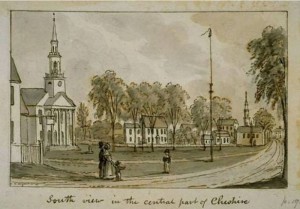By Nancy Finlay
When Thomas Hooker and his party reached Hartford in 1636, they would have found majestic elm trees growing in the meadows along the Connecticut River. The American elm is native to eastern North America and grows naturally in flood plains and other wet areas. By the early 1900s, elms were being widely planted throughout the state as shade trees and to line village and city streets. In the early 1830s, when John Warner Barber documented the appearance of every town in Connecticut for his book, Connecticut Historical Collections, mature elms were already prominent features in many towns. Elms can be recognized in Barber’s drawings by their distinctive umbrella shape—and also because the artist carefully labeled the individual trees in his preliminary drawings. Elms are noted in Canterbury, Cheshire, Ellington, Fairfield, Guilford, Norfolk, Sharon, Somers, Southbury, Windsor, and appear in other towns, most notably in several views of New Haven.

The Wethersfield Elm. Photograph by Frederick Brown, ca. 1890 – Connecticut Historical Society

South View of the Central Part of Cheshire. Wash drawing by John Warner Barber, 1836 – Connecticut Historical Society
Wethersfield Elm a Giant Among Its Peers
New Haven became known as the Elm City, because of the many elm trees that lined its streets and town green, creating leafy canopies of shade. Almost every town of any size has an Elm Street, named for the popular trees. Colchester, Manchester, and Winchester all have their Elm Streets; so do New Canaan, New London, and New Milford. Norwich boasts an Elm Avenue. The trees adapted well to the compacted soils—and later pavements—of these towns and not only survived but grew and thrived. Photographs from the early 1900s show many of the trees planted in the 1700s and early 1800s grown to immense size. The Wethersfield Elm, planted in 1758, was famous as the largest elm tree in America, over 30 feet in circumference and 100 feet high. It was sometimes described as “the most magnificent tree east of the Rockies.”
Dutch Elm Disease Devastates the Landscape
Connecticut’s stately elms began to die in the 1930s. A fungal infestation, originating in the Orient, was first identified in the Netherlands and became known as Dutch Elm disease. Spread by bark beetles, it ravaged the closely planted elms that lined Connecticut streets. Additional elms fell as the Hurricane of 1938 swept through the State. The majestic Wethersfield Elm succumbed to Dutch Elm disease in 1953. Isolated trees continue to survive, including the “High Street Elm” in Hartford, which is clearly visible to motorists on Route I-84, but they remain vulnerable. Recent efforts to treat the endangered trees with herbicides and to develop disease-resistant strains offer hope that these beautiful and goodly trees will remain a part of the Connecticut landscape in years to come.
Nancy Finlay grew up in Manchester, Connecticut. She has a BA from Smith College and an MFA and PhD from Princeton University. From 1998 to 2015, she was Curator of Graphics at the Connecticut Historical Society.
© Connecticut Public Broadcasting Network and Connecticut Historical Society. All rights reserved. This article originally appeared on Your Public Media
Note: ConnecticutHistory.org does not edit content originally published on another platform and therefore does not update any instances of outdated content or language.









